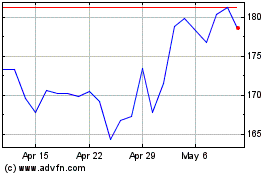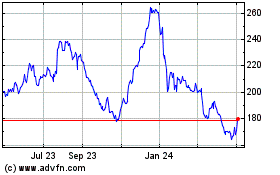Ethiopia Blames Design, Training Problems in Boeing 737 MAX Crash -- Update
March 09 2020 - 6:13PM
Dow Jones News
By Andy Pasztor
Faulty aircraft design and inadequate pilot-training
recommendations from the manufacturer led to the fatal crash of a
Boeing Co. 737 MAX jet after takeoff from Addis Ababa in Ethiopia a
year ago, according to an accident report issued by Ethiopian
investigators.
The interim report released Monday about the crash of Ethiopian
Airlines Flight 302 provides some new technical analyses along with
details about the cockpit drama before the plunge -- with pilots
pulling back on the controls with more than 180 pounds of force to
no avail. But the document indicates that neither pilot errors nor
potential airline slip-ups contributed significantly to the tragedy
that killed all 157 on board.
The findings contrast with a series of other government and
industry reports that highlighted the important interplay of causal
factors, ranging from Boeing's misguided engineering assumptions to
lax regulatory oversight to at least one significant incorrect
pilot command.
Monday's report gives short shrift to such contributing causes
and focuses largely on Boeing's failings in devising a powerful new
automated flight-control feature, called MCAS. That feature, which
ended up aggressively and repeatedly pushing down the nose of the
Ethiopian airliner, is being fixed before the global MAX fleet
returns to service.
The global MAX fleet has been grounded since the March crash,
touching off the biggest corporate crisis in Boeing's history and
sending ripple effects throughout the aviation industry.
The report mentions but doesn't elaborate on a central question
of why Ethiopian pilots, after turning off MCAS as required by an
emergency checklist, ultimately flipped a switch that reactivated
the feature that overpowered their efforts to pull out of the
plane's dive.
Within seconds, the plane became uncontrollable and ended up
with its nose pointing down 40 degrees from level flight.
The interim report, among other things, concludes that the heart
of the pilot training "provided by the manufacturer was found to be
inadequate." It also indicates that certain cockpit alerts,
designed to help pilots diagnose sensor malfunctions that could
trigger a hazardous MCAS misfire, didn't work as intended or as
they were described in the flight-crew operation manual. The final
conclusions are expected later this year.
A spokesman for Boeing said the company continues to provide
technical assistance in support of the Ethiopian-led investigation
and looks forward to "reviewing the full details and formal
recommendations that will be included in the final report."
The U.S. Federal Aviation Administration, which has been
criticized by congressional investigators and others for delegating
too much authority to Boeing in initially vetting safety of the 737
MAX, said it is reviewing the interim findings. An email from a
spokesman added: "We believe it's important to have the full final
report to evaluate it against other independent reports, so that we
might fully understand all of the factors -- both mechanical and
human -- that played a role in this tragic loss of life."
The report also reveals, for the first time publicly, some other
fundamental MAX design shortcomings. Investigators laid out the
results of ground-simulator tests they conducted that pinpointed
the difficulty of pilots cranking a control wheel in an emergency
to counteract automated MCAS commands.
Particularly at higher simulated speeds and altitudes, according
to the report, those manual actions to raise the nose required
pilots to exert forces that were "very high and unbearable" for the
required time periods. Some emergencies required dozens of turns of
the wheel, the report indicates, while in others pilots couldn't
budge the control wheel at all because of airflow forces pushing on
flight-control surfaces.
After the Ethiopian crash and another MAX crash that occurred in
Indonesia less than five months earlier, foreign regulators have
criticized the FAA for failing to adequately flag such problems
associated with manually moving an essential flight-control surface
on the tail.
Regarding the role of Ethiopian Airlines, the report found the
jet didn't have any technical problems prior to takeoff. But
similar to findings in a preliminary report released by Ethiopia
last year, the narrative spelled out the cacophony of warning
sounds and lights, accompanied by a vibrating control column, that
enveloped the pilots as they struggled to understand what was
happening.
Write to Andy Pasztor at andy.pasztor@wsj.com
(END) Dow Jones Newswires
March 09, 2020 17:58 ET (21:58 GMT)
Copyright (c) 2020 Dow Jones & Company, Inc.
Boeing (NYSE:BA)
Historical Stock Chart
From Jun 2024 to Jul 2024

Boeing (NYSE:BA)
Historical Stock Chart
From Jul 2023 to Jul 2024
